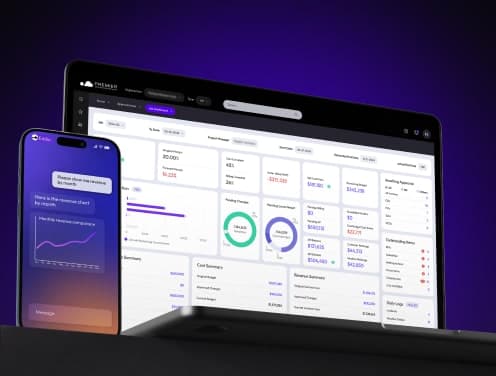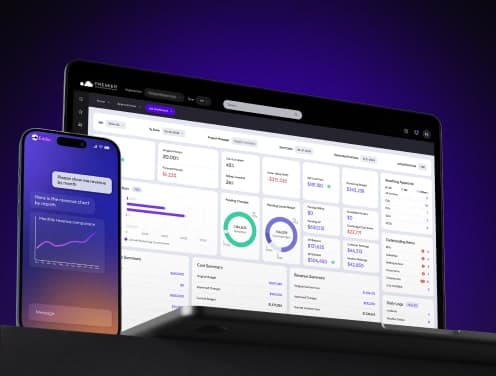
Construction Accounting vs Regular Accounting: Hidden Industry Differences You Should Know
Construction accounting differs from regular accounting in ways that affect your bottom line. Companies that switched to specialized accounting software saw remarkable results - 67% of construction firms increased their profits by 14% on average.
Construction accounting focuses on projects, unlike standard accounting practices. Each project becomes a standalone profit center that needs detailed financial tracking. The differences are clear. Material costs change often and projects face unexpected modifications. You need quick adjustments to maintain accurate finances.
Construction businesses deal with unique contract elements too. Retainage clauses hold back 5% to 10% of the total contract value until completion. This affects your cash flow differently than regular businesses. The ASC 606 standard asks you to recognize revenue based on performance obligations. This marks a big shift from older methods.
Project-based financial performance is harder to assess because costs and timelines vary. Job costing becomes crucial - each project's expenses need separate tracking. Premier's construction accounting software offers specialized tools that make job costing and billing easier to handle.
This piece shows you the key differences between construction and regular accounting that shape your profitability. You'll learn to handle these differences better for improved financial outcomes.
What is Construction Accounting and How is it Different?
Construction companies work in a financial reality that sets them apart from other businesses. The numbers tell the story clearly. The Construction Financial Management Association (CFMA) found that 76% of construction companies saw better project profits when they used specialized accounting systems. Only 34% achieved similar results with general accounting software. This stark difference shows why your bottom line depends on knowing what makes construction accounting unique.
Definition of construction accounting vs regular accounting
Construction accounting is a specialized way to handle finances in the building industry. Regular accounting looks at overall business health, while construction accounting treats each project as its own profit center.
Regular accounting works best for predictable business operations, like retail stores where locations stay fixed and product costs remain stable. Construction accounting takes a different path. It ties costs to specific contracts and tracks how each project performs financially.
Both types share basic principles but apply them differently. Regular financial reports include income statements, balance sheets, and cash flow statements. Construction businesses need a fourth crucial document, the work-in-progress (WIP) report. This report shows how contracts progress and tracks costs through long-term projects.
Cost tracking creates another big difference. Regular accounting separates direct costs from overhead expenses. Construction accounting takes a unique approach. It assigns selling, general, and administrative expenses (SG&A) to specific projects. This method gives a clearer picture of what each project really earns.
Here's what makes construction accounting different:
- Production location: Projects happen at changing job sites, not fixed locations
- Project timelines: Contracts often run across multiple years
- Cost fluctuations: Materials and labor costs change throughout projects
- Revenue recognition: Special methods track performance obligations
- Cash flow patterns: Payments take 30-90 days plus possible retainage
Why project-based accounting is essential in construction
Project-based accounting proves crucial because each job acts as its own profit center with unique variables. Companies can track money coming in and going out for every project.
Industry experts put it bluntly: "Construction companies don't go out of business because of lack of backlog; they go out of business because they run out of cash in the middle of a project". Project-based accounting helps prevent this outcome.
This approach solves several challenges. It helps manage workers and equipment moving between sites. The system handles revenue recognition for long-term projects. It also deals with unpredictable inventory needs caused by seasonal changes and varying costs.
Project-based accounting brings real benefits:
Costs stay properly assigned to each project. Profits improve through close monitoring of money flows. Resources get managed better, which cuts waste and delays. Better forecasting leads to smarter decisions.
Premier's construction accounting software gives you specialized tools for job costing and billing. Their system helps control finances throughout a project's life, from the original bid through final payment.
Companies without project-based accounting find it hard to compare projects or identify their most profitable work types. The project-focused approach provides detailed financial data that helps you choose the right projects and price them correctly.
To sum up, construction accounting works differently from regular accounting because projects drive everything. Changing work locations and long production cycles create unique challenges. These differences just need specialized accounting methods that treat each project separately while keeping the whole business healthy.
Revenue Recognition in Construction vs Regular Accounting
Revenue recognition is one of the most important areas where construction accounting differs from traditional accounting practices. The Financial Accounting Standards Board (FASB) created Accounting Standards Update 2014-09, known as ASC 606, to create uniform revenue recognition rules in all industries. Construction companies face unique challenges when applying these standards.
ASC 606 and performance obligations
ASC 606 has changed how construction companies record their income by focusing on performance obligations. Companies must follow these five steps:
- Identify the contract with a customer
- Identify performance obligations
- Determine the transaction price
- Allocate the transaction price to performance obligations
- Recognize revenue as performance obligations are satisfied
A performance obligation in construction represents a distinct good or service promised in a contract. Companies need good judgment to determine what qualifies as "distinct." Something becomes distinct if customers can benefit from it separately and if it stands apart from other contract promises.
Let's look at an HVAC installation project. Manufacturing ductwork, buying equipment, installation services, and maintenance could be separate performance obligations. These elements might form a single performance obligation if they blend together closely.
ASC 606 bases revenue recognition on whether control moves to the customer over time or at one specific point. Construction firms usually recognize revenue in two ways:
- Over time: Customers control the asset as it's built, or contractors have the right to payment for completed work
- Point in time: The project doesn't meet over-time criteria
Premier's construction accounting software helps companies track these obligations with tools that match ASC 606 requirements. This makes it easier for construction businesses to stay compliant.
Percentage of Completion vs Completed Contract methods
Construction accounting uses two main methods for revenue recognition: Percentage of Completion (POC) and Completed Contract Method (CCM).
POC recognizes revenue and expenses throughout a project based on completion percentage. This shows a clearer picture of financial performance. CCM waits until project completion to recognize all revenue and expenses.
Percentage of Completion Method:
Contractors can recognize revenue as work moves forward, usually monthly. They calculate completion percentage through:
- Cost-to-cost method: (Total costs to date ÷ total estimated costs)
- Units completed
- Labor hours
Here's a simple example: A $120,000 project has used $50,000 out of $100,000 estimated total costs. This means it's 50% complete, so $60,000 in revenue can be recognized.
POC works best when:
- Projects span multiple accounting periods
- Revenue and costs can be estimated accurately
- Both parties can meet their obligations
Completed Contract Method:
CCM keeps all project revenue and expenses on the balance sheet until completion. This careful approach makes sense when:
- Projects don't take long
- Costs are hard to estimate
- Small contractors qualify for exceptions
The IRS requires contractors to use POC for long-term projects. Home construction and small contractors (those earning less than $25 million in the past three years with projects finished within two years) can be exceptions.
Timing creates the main difference between these methods. A $2 million building project with $1 million in costs over three years would show up differently:
- POC: Revenue and expenses spread out as work continues
- CCM: All $2 million in revenue and $1 million in expenses show up after three years
Financial statements look very different depending on your choice. POC creates smoother financial reports, while CCM causes big changes when projects end.
Premier's construction accounting software gives contractors tools to track completion percentages, create work-in-progress reports, and record revenue correctly using either method.
Job Costing: Tracking Costs at the Project Level
Job costing serves as the foundation of construction accounting that works. The construction industry's labor costs can reach 60% of total expenses, which makes tracking project-specific costs a vital part of financial success.
Direct vs indirect costs in construction
Construction companies face unique cost categories that need different tracking methods compared to standard business expenses. Each construction project creates three main types of costs:
Direct costs are expenses tied to specific construction activities or projects. These include:
- Materials (concrete, steel, lumber)
- Labor wages for on-site workers
- Equipment used for the project
- Subcontractor fees
Indirect costs play a vital role in project completion, even though they don't link directly to specific construction activities. These costs fall into several categories:
Overhead costs are the foundations of business operations and include office rent, utilities, and storage facilities. General and administrative costs take care of day-to-day business operations, including non-project staff salaries. Project-specific indirect costs (let's call them general conditions) include temporary jobsite offices, site maintenance, and project manager salaries.
Committed costs represent a unique third category in construction - costs a company agrees to pay through purchase orders or contracts but hasn't paid yet. These costs include unposted payroll, open subcontractor agreements, and materials ordered but not yet billed.
Wrong cost classifications can throw off financial analysis and lead to budget forecast errors. To name just one example, wrong categorization of temporary structures as permanent building components affects current project analysis and future estimates.
Why job costing is more granular than standard COGS
Standard Cost of Goods Sold (COGS) accounting works well for businesses with steady operations and stable costs. Construction needs a more detailed approach through job costing.
Job costing examines expenses in specific categories and breaks them down into detailed segments like concrete, flooring, electrical work, and plumbing. This detailed tracking helps you spot areas where costs go over estimates and take quick action.
Job costing is different from standard COGS in several ways:
The system provides a more detailed cost calculation method that fits unique projects. It needs careful record-keeping to account for every item, worker hour, and overhead expense assigned to specific projects. The system blends job cost data with your general ledger to create a detailed view of project performance.
Job costing's strength lies in its accuracy. Careful tracking of each project cost helps you learn about profitability across your project portfolio. This detailed tracking improves estimates for similar future jobs.
Premier's construction accounting software gives you specialized tools that make job costing simple. Their system combines time tracking with accounting functions to help you monitor direct labor costs - a big deal as it means that labor typically makes up 60% of total expenses.
Accurate job costing helps you make smart decisions throughout a project's lifecycle. Without a system that connects time tracking to accounting, tracking direct labor costs becomes sort of hard to get one's arms around. Premier's construction software solves this by showing real-time insights into labor's effect on weekly progress.
Job costing ended up helping companies make more profitable decisions. Connecting your job cost ledger with your general ledger creates a detailed view of individual project performance and overall business health.
Overhead Allocation: Blurred Lines in Construction Projects
Construction accounting's treatment of overhead allocation stands out as a major gray area compared to standard practices. Overhead allocation in construction means spreading indirect costs among jobs that share these expenses.
Classifying shared resources like equipment and utilities
Construction projects face a unique challenge when it comes to the difference between direct and indirect costs. Construction companies work with resources that often serve multiple projects at once, unlike regular businesses.
Equipment shows this challenge perfectly. A dozer used on several jobs creates operating costs, including oil, maintenance, and operator labor, that need fair distribution to each project. No single job should carry the whole financial burden as a direct cost. Premier's construction accounting software handles this by keeping tabs on equipment usage across projects to distribute costs fairly.
Construction overhead costs split into two main groups:
- Direct overhead costs (job overhead): These expenses link to specific projects but don't fit cleanly into material or labor. Examples include:
- Project-specific insurance
- Temporary facilities like portable toilets
- Equipment rental for a particular job
- Site supervisor salaries
- Indirect overhead costs (general overhead): These expenses help run the entire business whatever the specific projects. Examples include:
- Office rent and utilities
- Administrative staff salaries
- Marketing and advertising
- General liability insurance
Shared utilities make classification even trickier. To cite an instance, a temporary water supply might serve multiple projects on adjacent sites. Projects often split these costs based on their size or how much they use.
Wrong cost classifications can bring serious financial risks. Industry experts say incorrectly labeling direct costs as indirect (or vice versa) throws off project profitability calculations and might cause you to underprice future jobs. This mistake clouds your view of which projects actually make money.
How overhead is treated differently in construction
Construction businesses take a unique approach to overhead by connecting these costs to specific projects. This project-focused method stands in sharp contrast to standard accounting, which sees overhead as a general business expense.
Companies can choose from several allocation methods based on their type:
Direct labor hours/cost method connects overhead to labor usage. Labor-intensive contractors benefit from this approach since projects using more worker hours take on more overhead costs. Premier's construction management software tracks these labor relationships with precision.
Direct cost method (percentage method) assigns overhead based on a project's share of direct costs. A project making up 15% of total direct costs gets 15% of allocable overhead. Companies with steady relationships between direct costs and overhead find this method useful.
Machine hours method spreads costs according to equipment usage time. Earthmoving or heavy construction operations that rely heavily on equipment get the most value from this approach. Projects needing more crane time, for example, carry more of that equipment's overhead burden.
Square footage method divides costs based on project size, making sense for building construction where bigger projects typically just need more overhead support.
Construction overhead allocation stands apart by linking indirect costs to specific projects, something standard accounting rarely does. Construction companies also track overhead more carefully, setting up separate cost pools for different types to allocate more accurately.
Your choice of allocation method shapes how profitable projects appear. A project heavy on labor might look nowhere near as profitable if you allocate overhead based on equipment usage instead of labor hours. This explains why construction accounting demands extra care with overhead allocation compared to regular businesses.
Retainage, Billing, and Cash Flow Timing
Construction accounting is different from regular accounting, especially when it comes to cash flow management. Studies show 100% of construction companies reporting late payments from clients. Companies need to understand these unique cash flow patterns to stay financially stable.
Understanding retainage clauses and their effect
Retainage is a unique part of construction accounting. Clients hold back 5% to 10% of each payment until the project ends. This protects clients if problems come up during construction. Contractors face big cash flow challenges because of this practice.
Here's how retainage works: Let's say your project needs 10 payments of $20,000 each with 10% retainage. The client pays $18,000 each time and keeps $2,000. You'll get the total held amount of $20,000 only after you complete the project successfully.
Retainage affects your business in several ways:
- Cash flow strain: You pay all costs upfront but receive only 90-95% of payments
- Compounding effect: Multiple projects can lead to tens of thousands in held payments
- Extended waiting periods: Some subcontractors wait months or years to get their final payment
The retainage system flows down the payment chain. General contractors often hold back money from subcontractors to help balance their own cash flow challenges.
Premier's construction accounting software lets you track retainage separately from main receivables. This prevents a common mistake of counting it as earned income. The software helps keep financial statements accurate and predicts cash needs for long projects.
Overbilling and underbilling scenarios
Construction accounting has unique ways to handle billing imbalances through "overbilling" and "underbilling" - concepts rarely seen in regular accounting.
Overbilling happens when you bill more than the work you've done. To cite an instance, billing for 30% completion when you've finished only 20%. This helps balance delayed payments that affect all construction companies. Yet billing too much upfront can cause cash problems later if you don't manage those funds well.
Underbilling means billing less than your completed work - like billing for 20% when you've finished 30%. This creates immediate cash flow problems with no upside. Poor progress tracking or slow paperwork often leads to underbilling.
You need to watch both scenarios closely. Your accounting system should track actual costs, completion percentage, and billed amounts. Premier's construction accounting software has special tools to keep this balance. It spots billing issues before they become serious problems.
Experts say the best approach is to bill according to your actual progress. Construction-specific accounting systems help maintain steady cash flow throughout the project.
Your cash flow timing is nowhere near what standard businesses experience. The construction industry's retainage holdbacks and "pay-when-paid" practices mean your company might wait 45-90 days after completing work to receive full payment. This extended payment cycle means you need more advanced cash management than typical businesses.
Profitability Analysis in a Project-Based Environment
Builders face unique challenges when analyzing profitability compared to standard businesses. A recent industry survey revealed that only 7.6% of builders know how to read work-in-progress (WIP) reports. This knowledge gap creates problems in financial management.
Why trend analysis is harder in construction
Construction companies cannot track profit trends like other businesses. Most companies analyze profits over similar time periods with consistent operations. Construction projects, however, come with varying scopes, timelines, and cost structures. These variations make it hard to analyze trends.
Multiple factors create these challenges. Interest rate changes disrupt the construction industry and lead to project delays and cancelations. Projects that once brought profits can turn into financial burdens when rates change.
Material costs change without warning and affect profit margins. Recent data shows price increases across materials: fabricated structural steel went up by 5%, lumber rose 2%, and aluminum mill shapes jumped 17% year-over-year. These price swings make it hard to compare profits between similar projects.
Labor shortages add another layer of complexity. About 92% of construction companies struggle to hire project managers, while 94% can't fill hourly craft positions. This shortage leads to varying labor costs between similar projects.
Projects that span multiple financial periods make it hard to compare quarterly or yearly results. Economic conditions often change during these extended timelines and affect profits regardless of how well the team performs.
Using WIP reports to track financial performance
Work-in-progress (WIP) reports are the life-blood of construction profitability analysis. These specialized reports show costs and revenues for each project period. They offer insights that standard financial statements cannot provide.
WIP reports help track financial performance in several ways:
- Financial accuracy - They track project revenue and costs to show the true financial picture
- Cost control - Teams can spot and fix cost overruns early
- Risk management - Regular checks help spot risks like delays that could hurt profits
- Transparency - Clear financial breakdowns help both internal teams and external partners
WIP schedules rely on four main numbers: costs to date, billings to date (from accounting), contract amount, and cost estimate (from project managers). Accounting and project management teams work together to create more accurate financial data.
Premier's construction accounting software comes with WIP reporting features that show project financials immediately. This helps companies avoid cash flow problems that happen when underbilled jobs take money from other projects.
Good WIP reporting affects your tax situation. Underbillings can make revenue look higher than it is, which means paying taxes on money you haven't earned. Accurate WIP reports do more than help operations - they protect your company's bottom line.
Compliance and Multi-Entity Challenges in Construction
Construction accounting has unique compliance requirements that set it apart from standard practices. Industry-specific regulations create complexity that regular businesses rarely encounter.
Certified payroll and union wage requirements
Federal construction projects just need certified payroll reporting, which standard accounting doesn't require. Contractors working on federally funded projects must submit Form WH-347 every week. This form carefully tracks each worker's hours, wages, and benefits to ensure they receive the legally required common wage.
Here's what makes this process unique:
- Each labor classification has specific minimum pay rates
- Contractors must categorize work performed precisely
- The Statement of Compliance requires legal certification
- Projects need record preservation for at least three years after completion
Union contracts create extra complexity. Each collective bargaining agreement sets specific wage rates and benefits. Workers from multiple unions mean you must track different overtime rules, fringe benefits, and reporting requirements at the same time.
Premier's construction accounting software tackles these challenges with specialized certified payroll reporting tools that automatically apply correct wage determinations to each worker classification.
Managing multi-state and multi-entity operations
Construction businesses typically create separate legal entities for each state of operation. This strategy makes tax compliance easier but adds accounting complexity. Contractors face state-specific payroll considerations that multiply as they cross borders.
State reciprocity agreements play a crucial role in construction. These agreements determine which state claims tax rights when employees live in one state but work in another. Poor tracking can lead to duplicate taxation or compliance failures.
Multi-entity construction companies struggle with intercompany transactions. Traditional accounting systems have trouble reconciling transactions between business units, which often delays audits and tax filings.
Multi-state operations require attention to:
- State-specific wage laws that override federal minimums
- Various tax filing deadlines and formats
- Different unemployment insurance contribution requirements
Premier's construction accounting software has multi-entity capabilities that standard accounting platforms lack. This eliminates the need for manual Excel consolidations at month-end.
Choosing the Right Construction Accounting Software
Specialized software can revolutionize how construction companies handle their accounting needs. Simple accounting platforms don't deal very well with industry-specific requirements as construction projects become more complex.
Premier's construction accounting software overview
Premier Construction Software is a cloud-based ERP system created specifically for construction businesses. With a 4.7/5 rating from 278 users, this comprehensive platform merges:
- Financial management and accounting
- Job costing and project management
- Field operations and document control
- Approval workflows for invoices, RFIs, and purchase orders
Premier solves a major headache by eliminating the need to connect multiple systems. Teams that switch to Premier save 10-12 hours each week. This saved time goes directly into project management rather than paperwork.
The software simplifies everything in construction accounting with features like contra to AP, file customization, cost plus billing, and progress billing reporting. Companies can easily track their finances across multiple entities through Premier's dashboard.
Benefits of integrated ERP like PremierCS for job costing and billing
Job costing capabilities form the core of Premier's value. The system simultaneously tracks five cost types: actual cost, original estimate, change orders, estimate at completion, and committed cost. Automatic variance calculations help teams quickly identify budget concerns.
The billing system adapts to various contract structures in construction. It handles both time and materials billing with unlimited markup options and progress billing/AIA with customizable forms.
This integrated system offers clear advantages over separate solutions:
Users click 80% less compared to server-based alternatives. The platform provides clear visibility into workflow status, contracts, and payments. Teams can make decisions quickly based on live project data.
Construction companies now have better control over financial complexities that make their accounting needs unique from standard practices.
Conclusion
Construction accounting differs from regular accounting practices in key ways. This piece has shown how construction's project-based nature creates unique financial tracking needs. Your construction firm must treat each project as its own profit center, unlike standard businesses. The firm needs specialized methods for cost tracking, revenue recognition, and financial analysis.
Project-centric approaches form the core of construction accounting. Job costing helps track expenses at detailed levels that standard COGS accounting can't match. These detailed insights make a big difference when you analyze which projects generate actual profit. The ASC 606 standard has changed how companies recognize revenue, which requires careful attention to performance obligations and project completion percentages.
Cash flow timing creates another crucial difference. Regular businesses receive payment shortly after delivery, but construction companies deal with long payment cycles. Retainage clauses hold back 5-10% of your contract value for months or years. Your company must fund all project costs while receiving only 90-95% of payments until completion.
Your choice of overhead allocation methods affects how you measure project profitability. Construction companies must spread shared costs across multiple projects - a rare practice in standard accounting. Projects can lose money without accurate cost allocation.
Project profitability analysis becomes trickier due to different scopes and timelines. Standard trend analysis doesn't work well when comparing vastly different projects. WIP reports are essential tools to track financial performance accurately.
Premier Construction Software tackles these challenges with tools built specifically for construction businesses. Their accounting software saves construction companies 10-12 hours weekly. It streamlines job costing, billing, and financial reporting processes. The system tracks five different cost types at once, showing budget issues before they become serious problems.
Your accounting methods and software choices affect your bottom line by a lot. Construction-specific accounting isn't optional, it's a financial must-have. Companies see real results, as 67% of construction firms increased profits by 14% after switching to specialized accounting software.
Construction accounting needs specialized knowledge and tools that match the industry's financial patterns. The field applies standard accounting principles differently to fit construction's project-based nature. Premier's construction management software bridges this gap with solutions tailored to your construction business's daily challenges.





















